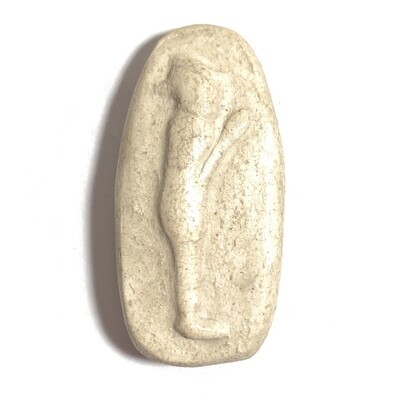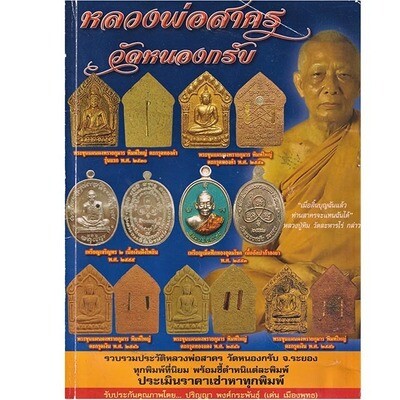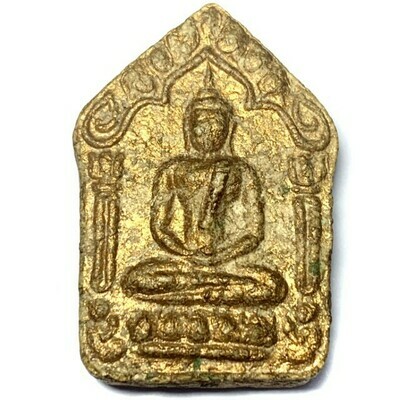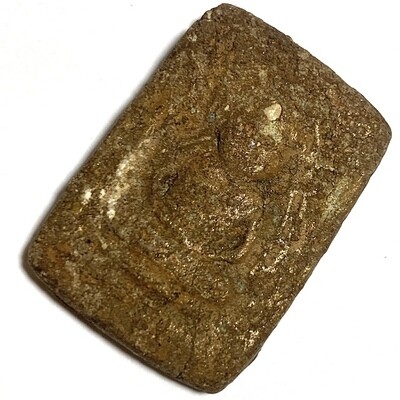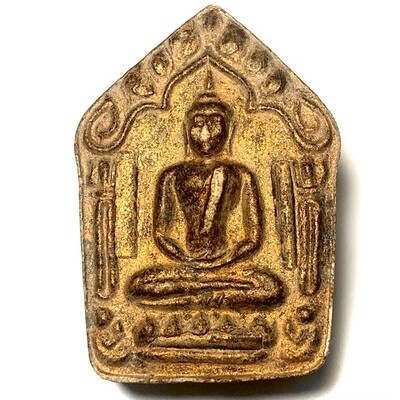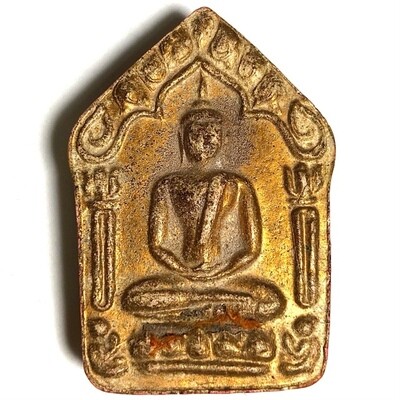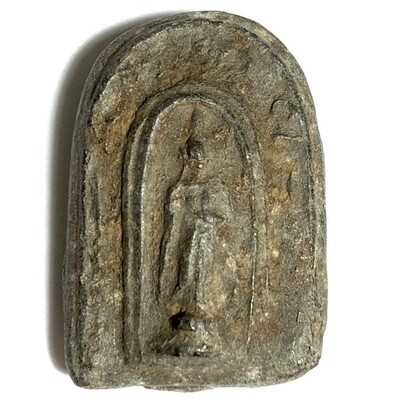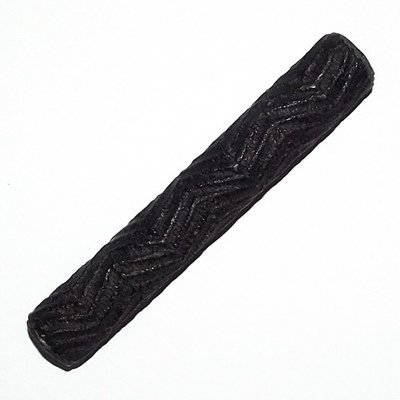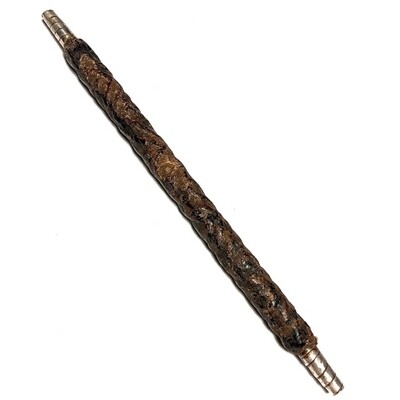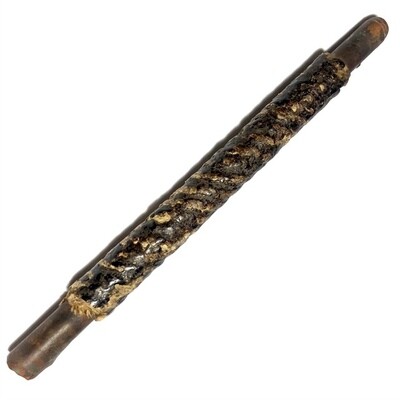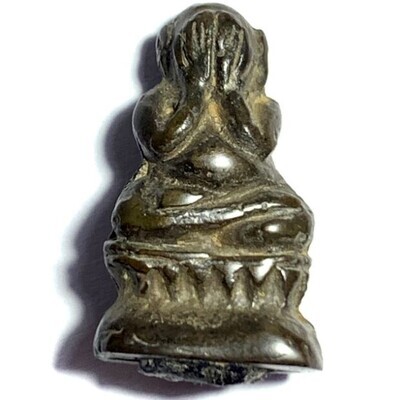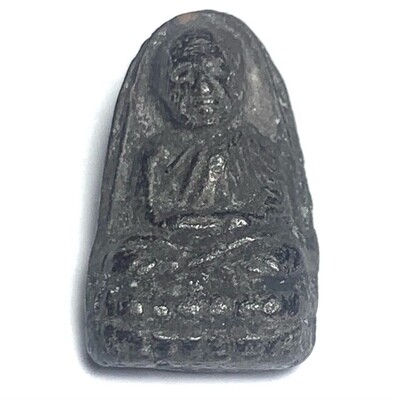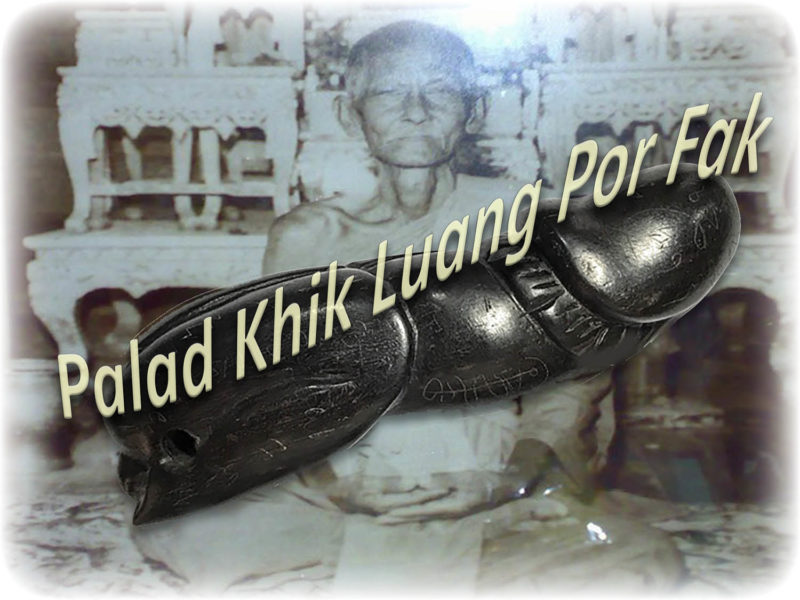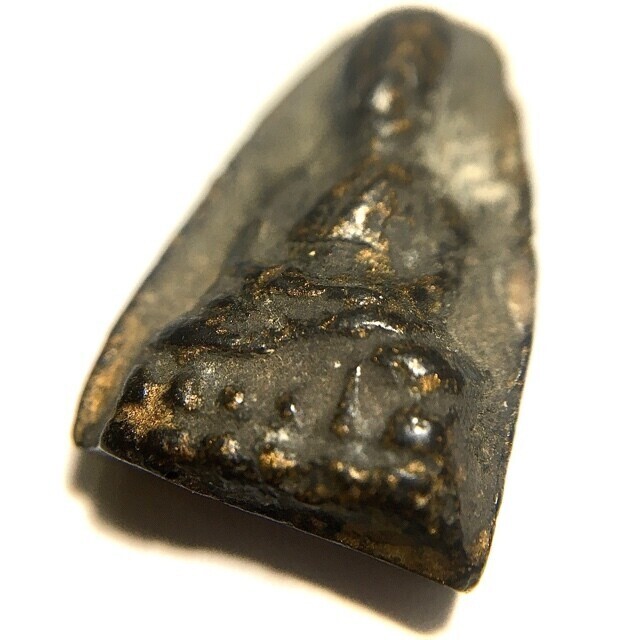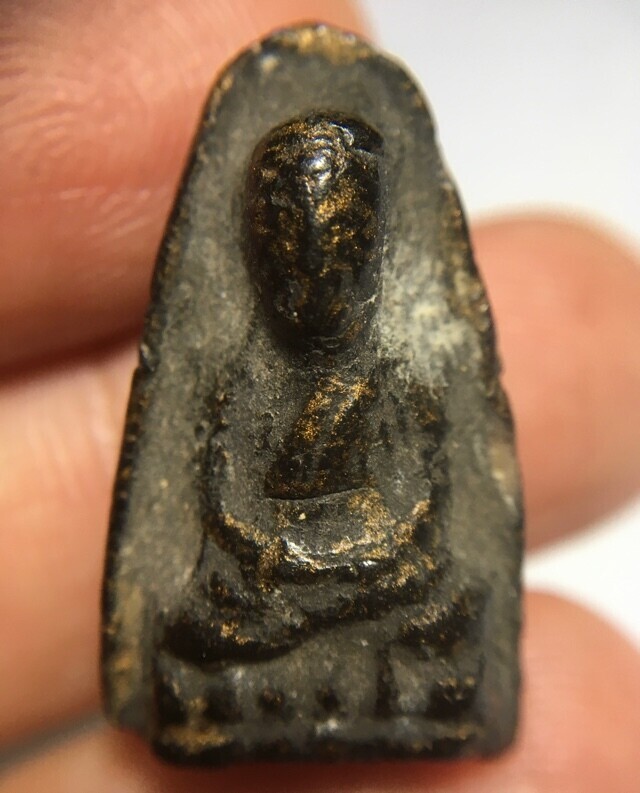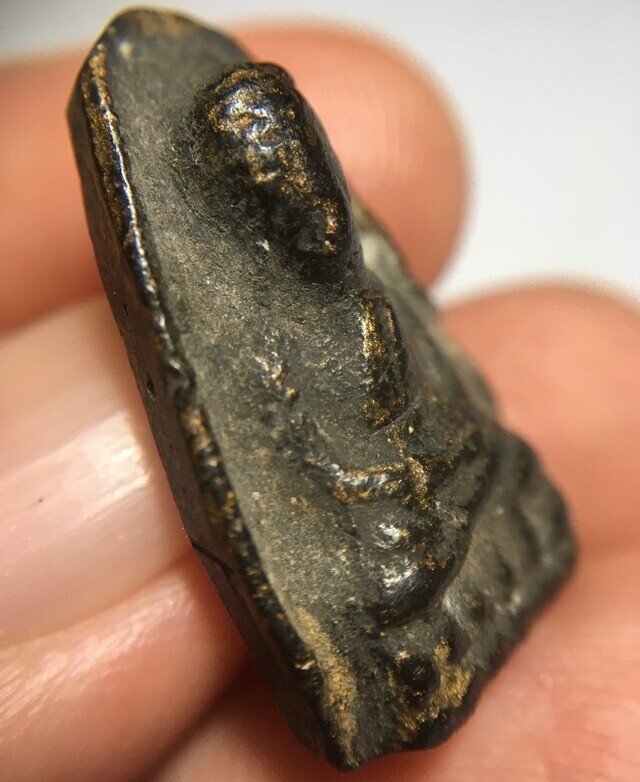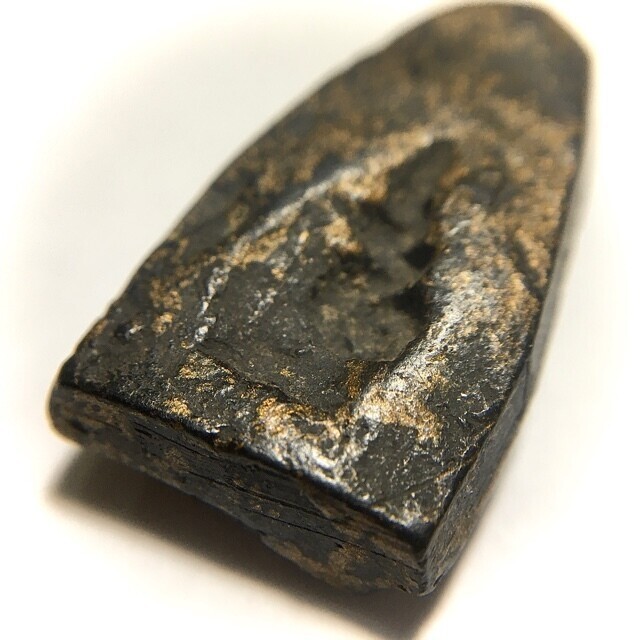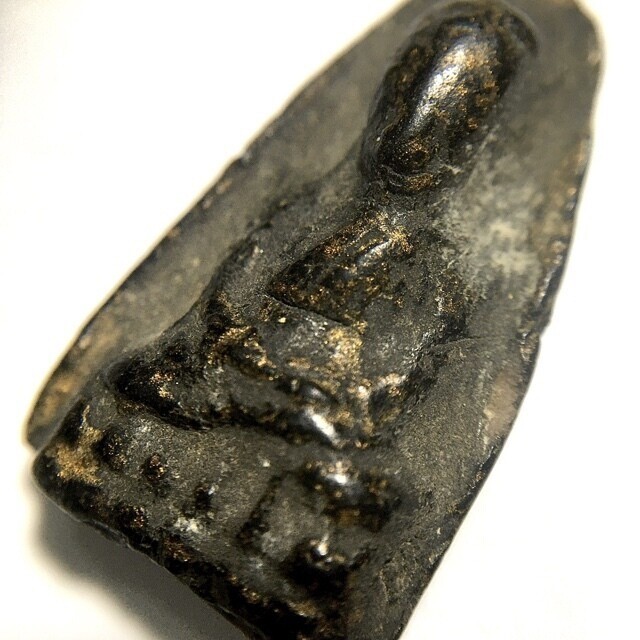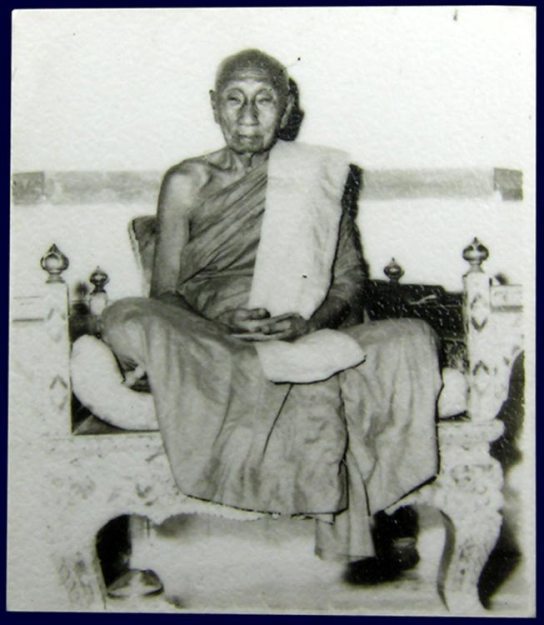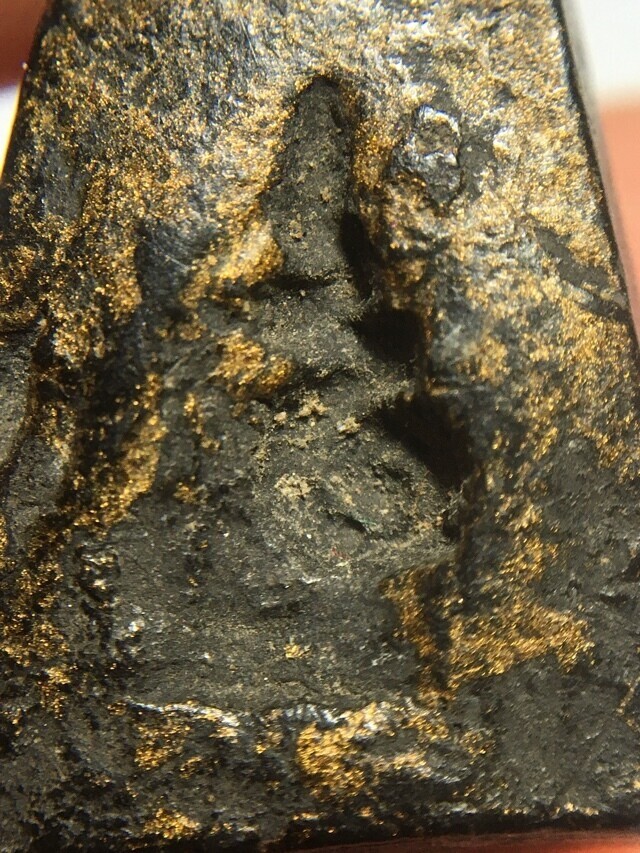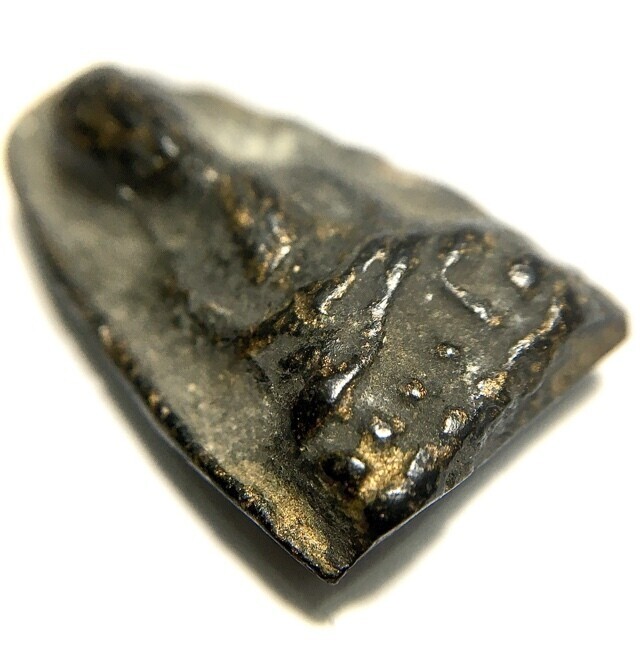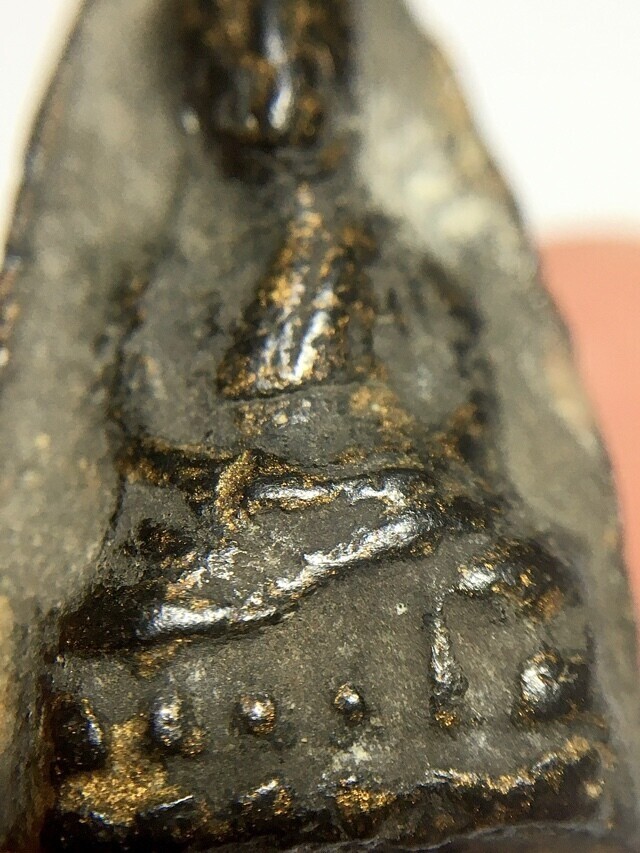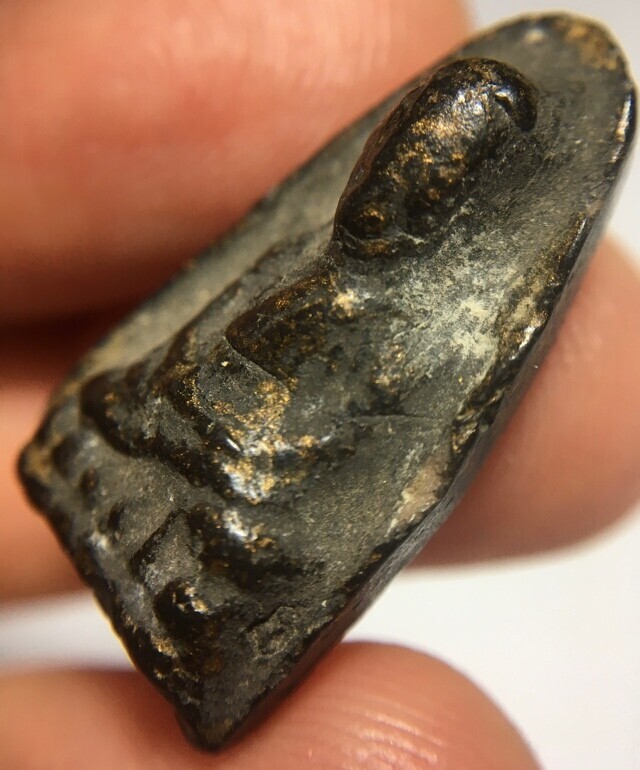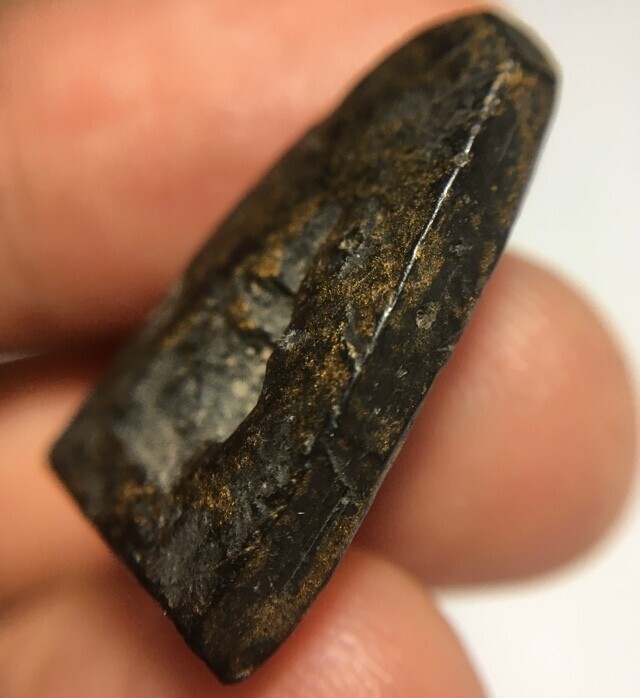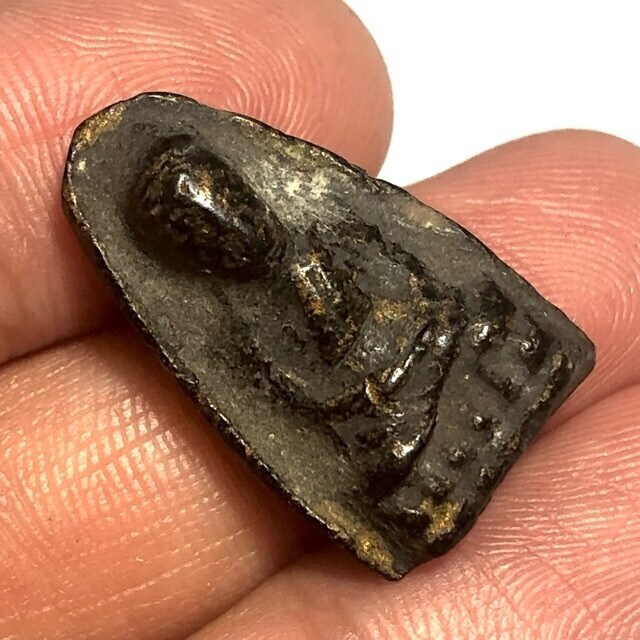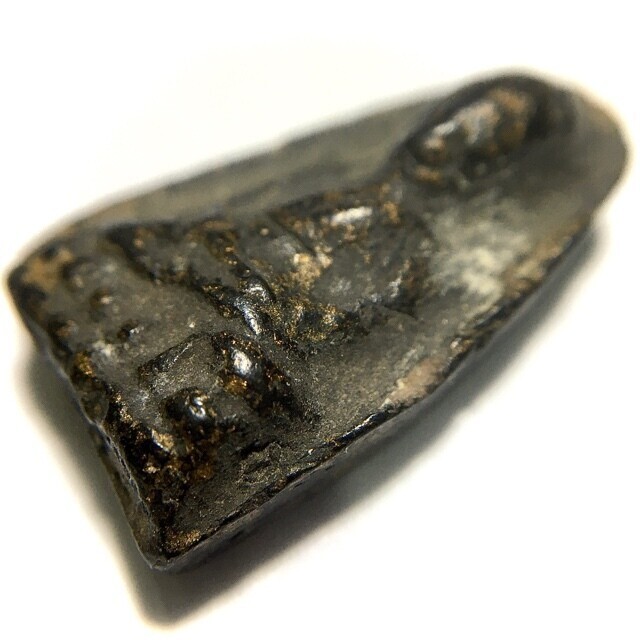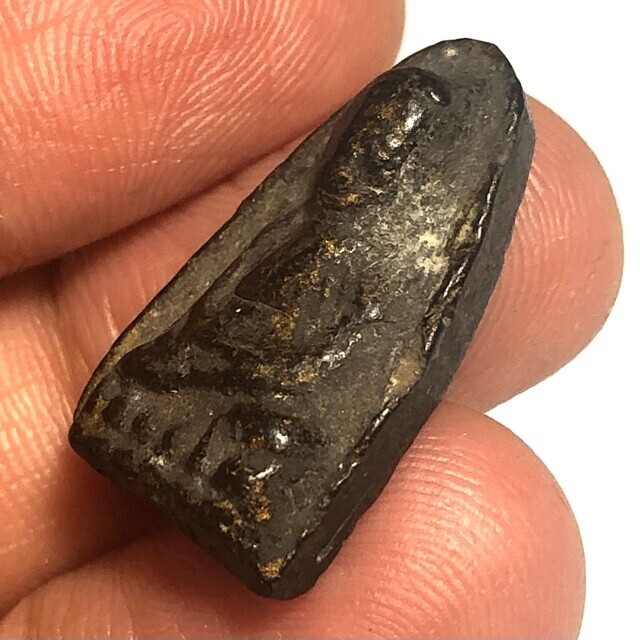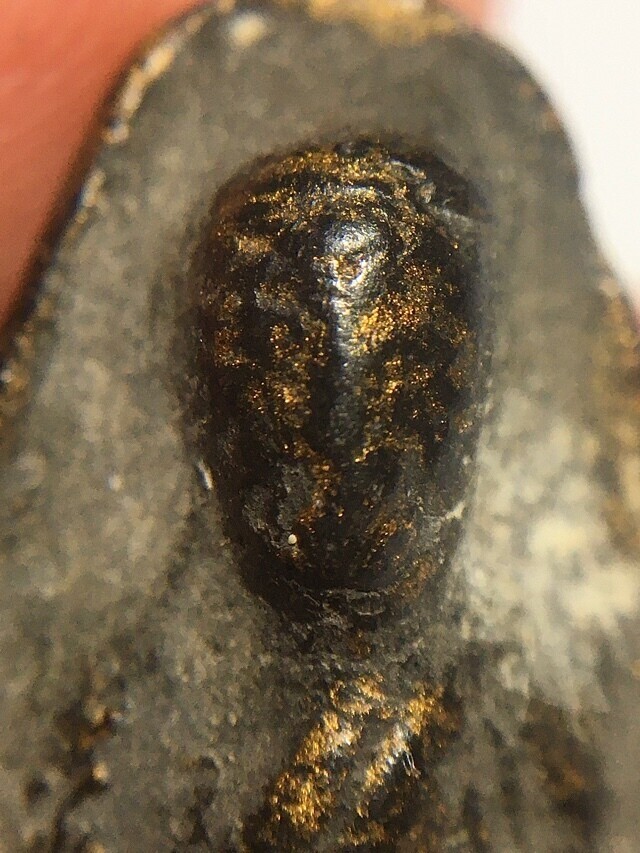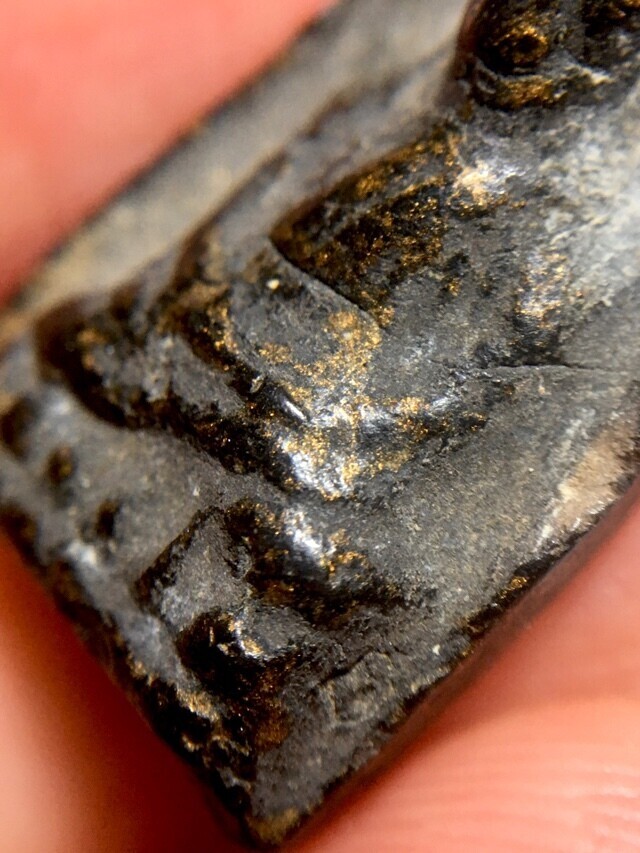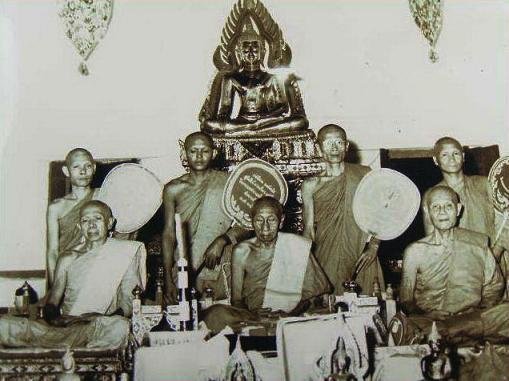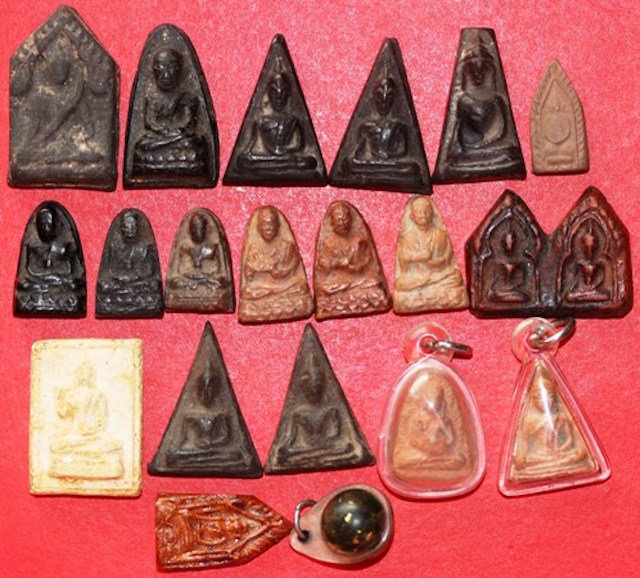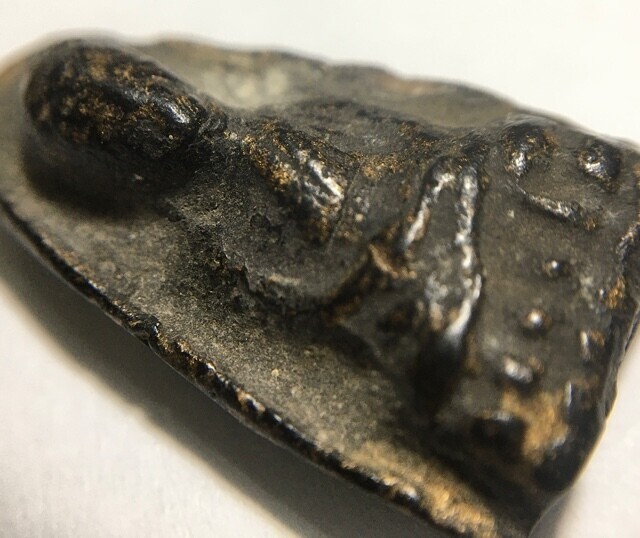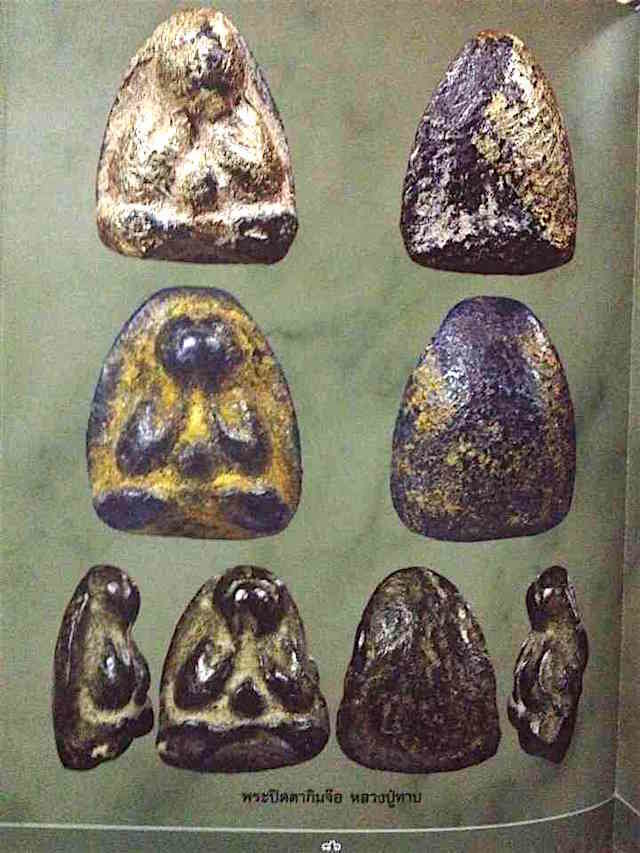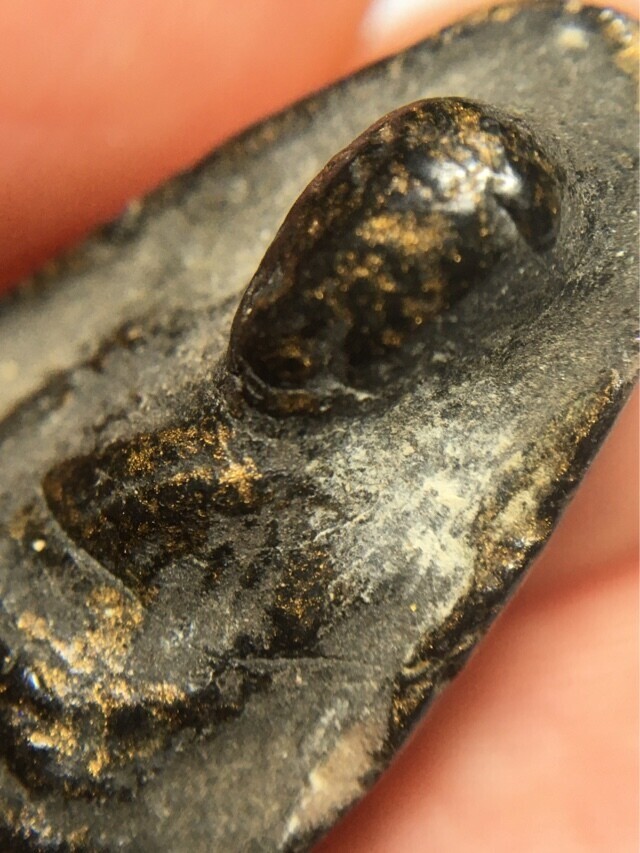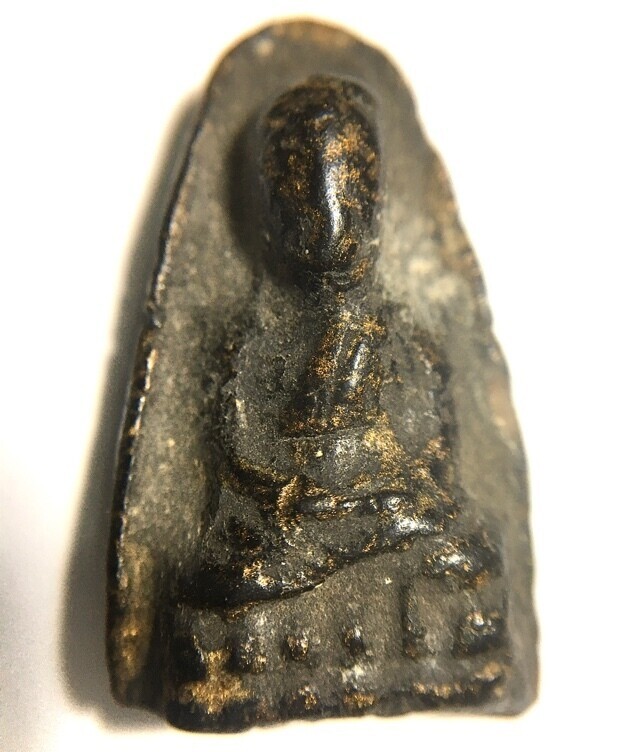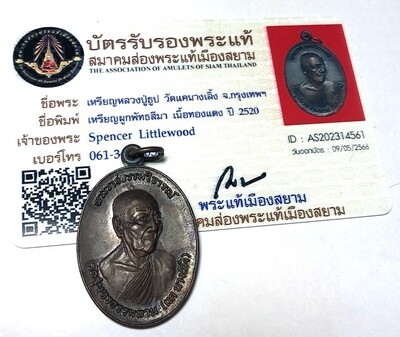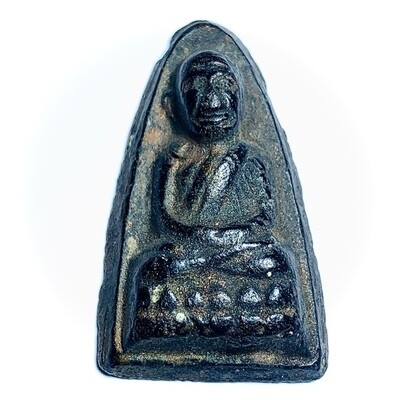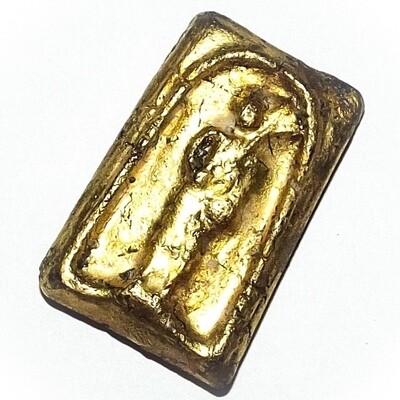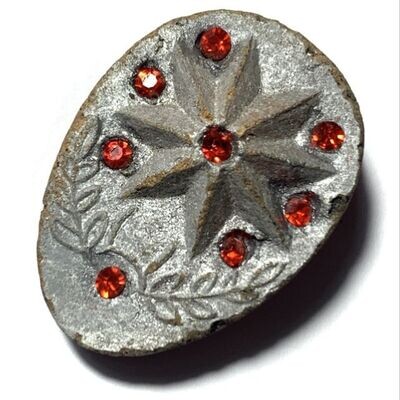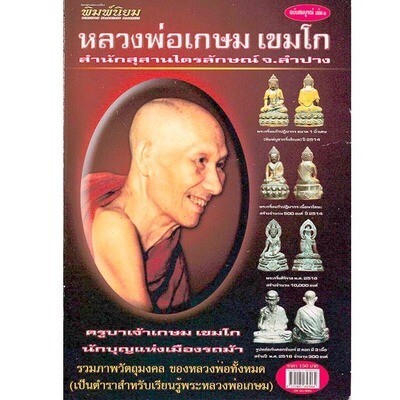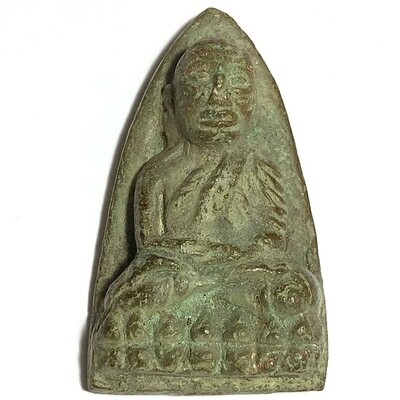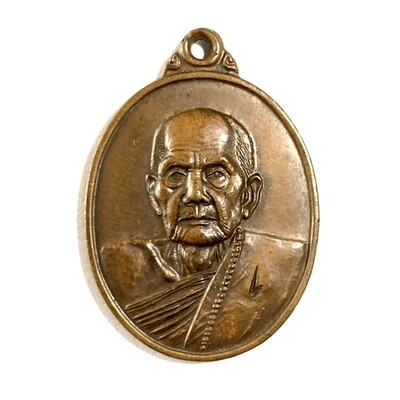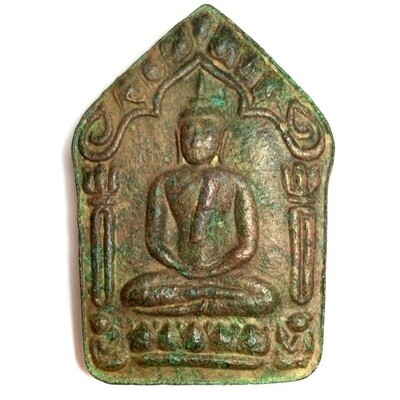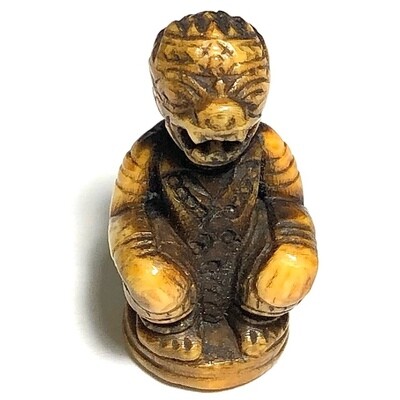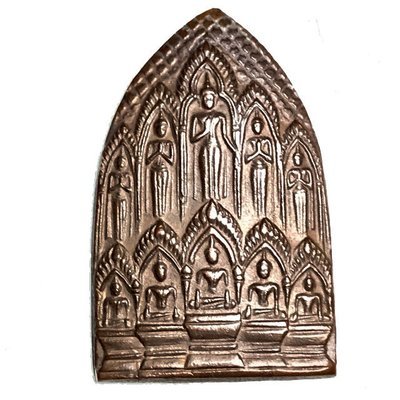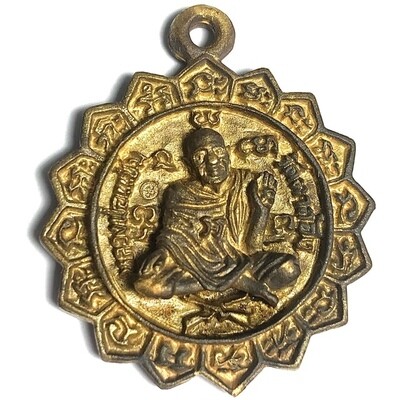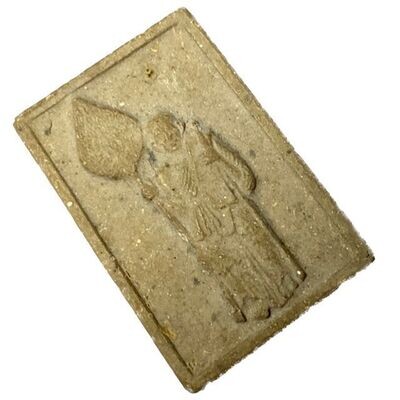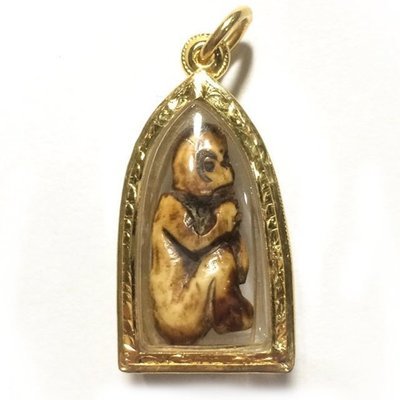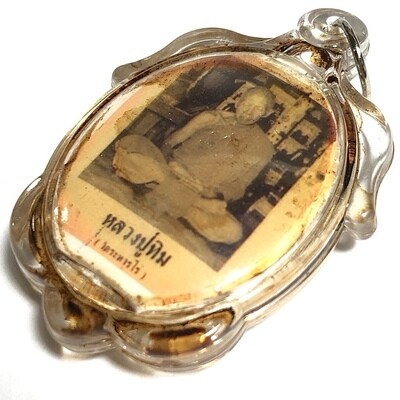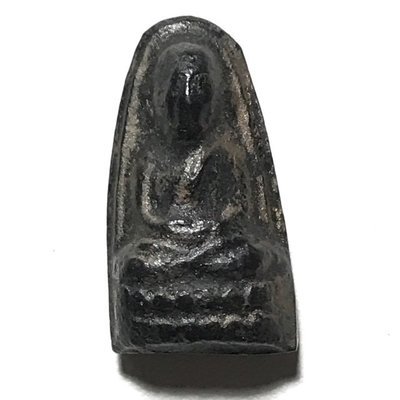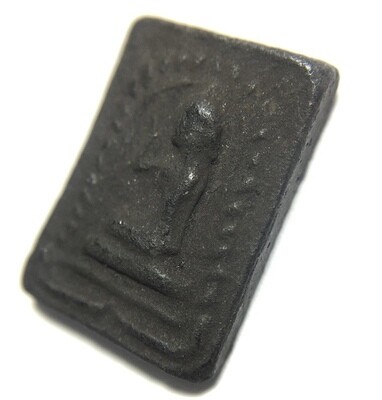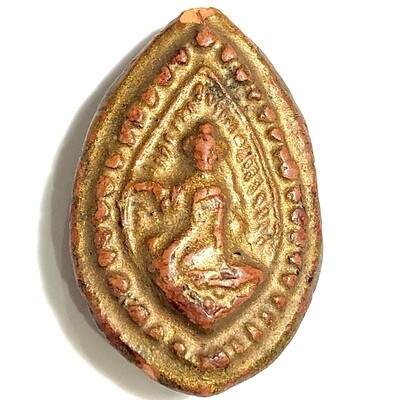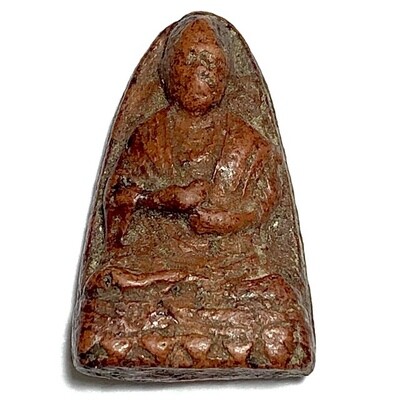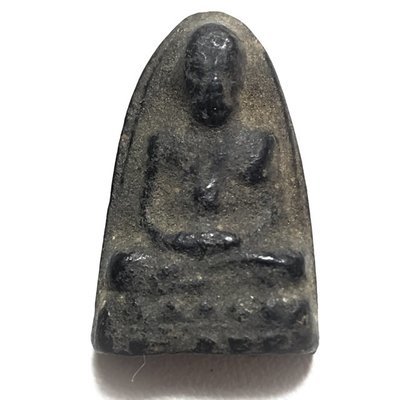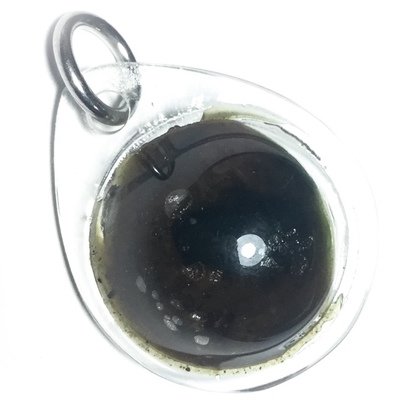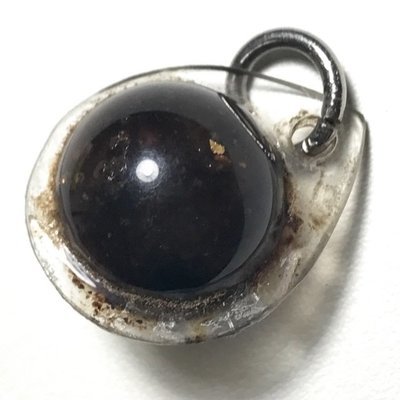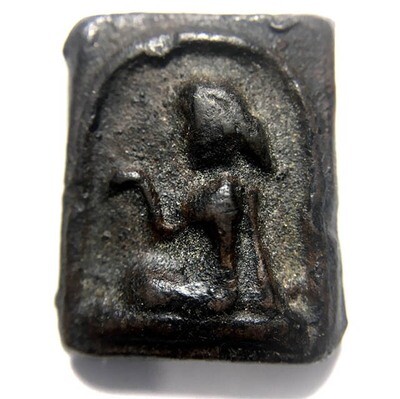One of the rarest and most highly revered and sought after Palad Khik of all Time, the Palad Khik Gae Nuea Mai Paya Ngiw Dam Dong Jarn Mer, of Luang Por Fak, of Wat Nikom Prachasan. Hand carved from sacred Deva inhabited black Ngiw treewood. The Palad Khik of Luang Por Fak is considered amongst the top five Palad Khik of all time, and carries Supreme Eminence in the Thai Collector Scene of the Krueang Rang Category, and for all Devotees of Palad Khik amulets.
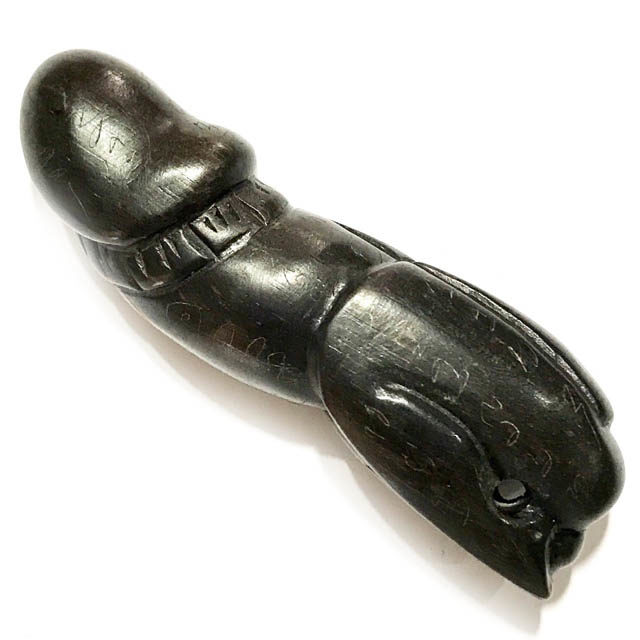
Palad Khik Mai Ngiw Dam Dong LP Fak with Hand Spell Inscriptions
Little is known of his Biography or Life before ordination, but it is known that he was the apprentice in Wicha to the great Luang Por Soke (also top 5 Palad Khik Master), and was the4 Kroo Ba Ajarn who taught the Wicha Palad Khik to the Great Luang Por Yid, of Wat Nong Jork. This Palad Khik from Luang Por Fak is in Pristine condition and exquisitely carved in the classic uniquitious curved shape which has come to be a trademark with the Palad Khik of Luang Por Fak.
A hole is drilled through the base of the Palad Khick for threading a cord through and attaching to a waistcord belt, or can alternatively be encased in waterproof casing with pendant hoop for wearing on a neckchain or belt as preferred.
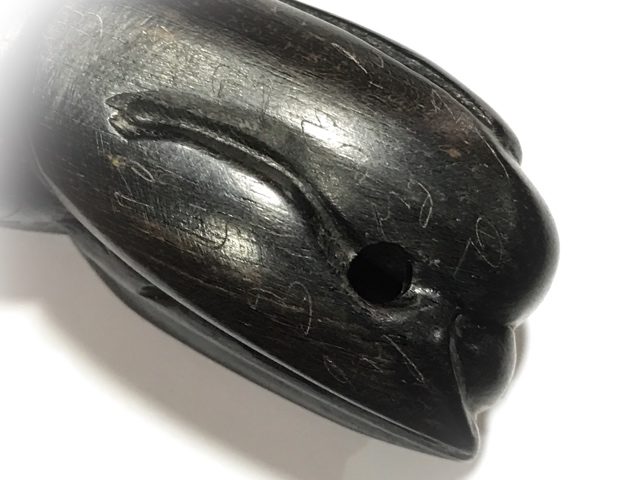
Hole drilled in base of Palad Khik Mai Ngiw Dam Dong LP Fak, for threading a cord for attachment to a belt or neckchain – Hand spell inscriptions can be seen on the surface of the sacred black Paya Ngiw Dam Dong Treewood.
The back of the Palad Khik has three holes where special Muan Sarn is inserted. The body of the the Palad Khik is formed in the clasic curved shape which has become known to be ubiquitous with the Palad Khik of this Master. This exhibit is extremely rare for the hand inscription of the Yant Dan Dta (Yant Dto) on the head of the Palad Khik, which is said to be found on only very rarely.
The Palad Khik of Luang Por Fak are highly renowned for Kong Grapan Chadtri (Invincibility), Klaew Klaad (Evasion of Deadly Accidents), Metta Maha Niyom n(Mercy Charm), Kaa Khaay (Selling Power), and Lai Phuudt Phii Pisaj (Chase Demons and Ghosts Away).
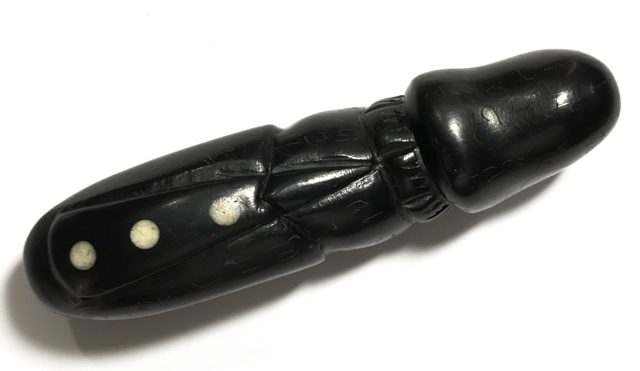
3 Muan Sarn Inserts in the Palad Khik Mai Ngiw Dam Dong LP Fak
The Palad Khik is empowered with the Kata; NA HI HA HU JA CHA DAN DTA
And the Kata Hua Jai Taw Waes Suwan “WAE SA PU SA”, and the Kata Hua Jai Ittijae for Metta Maha Sanaeh “I TA KA MA”, as well as the Kata Hua Jai Metta Karaniya Sutta “AE DTANG SA DTING”, topped off with the Hua Jai Maha Ud “UT TANG AD TO”.
11 Kinds of Blessings are included within the Magic of the Palad Khik’s Wicha; 1. Sleep peacefully, 2. Awaken with Happiness, 3. Protection against all Deadly Weaponry, 4. Immunity to Poisons, 5. Mercy Charm, 6. Good Business and Wealth Increase, 7. Convincing Speech, 8. Ward off Evil Spirits and Ghosts, 9. Improve Karma, 10. Protect Household and Property, 11. Increase Popularity & Chances of Promotion.
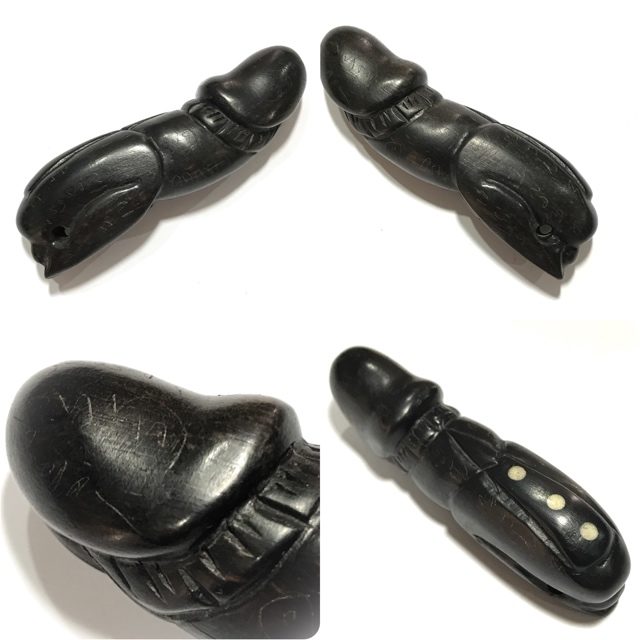
Palad Khik Mai Ngiw Dam Dong LP Fak
The Palad Khik is an Ancient Wicha, whose development can be traced right back to the Vedic Brahman Occult practices of Thousands of Years ago. Palad Khik amulets must be empowered by the repetition of incantations, which Thais call ‘Kata Bucha’, derived from the Devanagari ‘ghata poojah’. The incantations depend on the creator’s lineage in each school of traditional non-Buddhist animist magic.
Kata Bucha Palad Khik
Ganha Neha Na Ma Pa Ta
or
Ja Pa Ga Sa Na Mo Put Taa Ya Gan Ha Nae Ha Na Ma Pa Ta
or
Om Siwaling Sabbha Metta Sabbha Pokaa Sabbha Laapo Sabbha Tanaa, Sabbha Yasa, Sabbha Pranee Sabbha Mangalaani Bhavantume.
or
Om Laluay Mahaa Laluay Samsip Sorng Hee Hae Hom Lorm Dtorm Kuay Khor Hai Guu Ram Ruay Pro Hua Kuay An Nii Da Daa Di Dii Duu Dii Hee Maa Kuay Maa Burut Maa Dii Sadtrii Mii Maa Swaa Home
chant any one, or all of the Kata 3 times holding the Palad Khik before wearing
Pra Roop Muean Pim Lek Niyom Hlang U Nuea Pong Dam Pasom See Pheung Khiaw 2506 BE Luang Por Tarb
Pim Lek small version (2.2 x 1.5 Cm), of the 'Hlang Yant U Niyom' preferred model of the Pra Roop Muean Luang Por Tarb Guru Monk amulet, in Nuea Pong Dam Pasom See Pheung Khiaw (Hlang U). A very rare and popular amulet for Metta, Maha Lap, and Klaew Klaad Kong Grapan, from Luang Por Tarb, of Wat Grabok Kheun Pheung. This amulet isd also beloved by devotees of Luang Phu Tim (Wat Laharn Rai), who was present to join Luang Por Tarb for the empowerment ceremony. Luang Por Tarb (2420 - 2509 BE), of Wat Mai Grabok Kheun Pheung, was a Master Gaeji Ajarn Guru Monk of Yesteryear, famous for Metta Mahanyom Magic, and a well known companion in Magical Studies with the Great Luang Phu Tim, of Wat Laharn Rai.
The amulet is made in black Pong Bailan powders other Muan Sarn collected over years of forest wandering, mixed with Luang Por Tarb's legendary See Pheung Khiaw Green Prai Oil Balm. Released in the Ngan Phuug Putta Sima temple boundary installation celebration, in Buddha Abhiseka Ceremony of 2506 BE
The Muan Sarn Sacred Powders contained the following; Pong Wised Gao (old sacred powders from Luang Por Tarb's repository) 2. See Pheung Khiaw Luang Por Tarb, 3. Pong Bpathamang and Pong Ittijae from Ajarn Pathom Arj Sakorn 4. Pong Thaan Kampir Bailan (Parchment Grimoire soot) 5. Pong Wised special powders from Luang Phu Bun Mee of Wat Po Sampant, and 6. Pong Din Mongkol of Luang Por Tarb.
The See Phueng Khiaw Green Prai Oil Potion used to mix with the Muan Sarn powders of this edition is a legendary substance in itself, and is one of the most highly preferred See Pheung Potions with serious aficionados of the 'Krueang Rang' talismanic amulets Genre. Luang Por Tarb used the See Pheung to mix with all of his Sacred Powder amulets, which has made them a Genre of their own, with a very devoted following of devotees and collectors who value the magic of the Pra Pong Pasom See Pheung Khiaw amulets.
The front face of the amulet features the image of Luang Por Tarb, within the classic tapered arch we have all come to know as the classic 'Pim Tao Reed' clothes-press shaped amulet which has come to be synonimous with Luang Por Tuad. This series featured Luang Por Tuad Tao reed amulets, and so the Roop Muean images of Luang Por Tarb were made using the same shape and style as the Luang Por Tuad models, to remain in style with the edition.
There were various sizes of Roop Muean and LP Tuad models, all of which are now very rare, and immensely sought after acquisitions. Although it is still sometimes possible to find the odd amulet of Luang Por Tarb, it is becoming ever rarer these days to see one in circulation in the Public Amulet Exchanges, and one can definitely say that his amulets are amongst the rarer ones to see in the present day. This series has always enjoyed extreme popularity, as the Pra Pong Pasom See Pheung Khiaw series amulets of Luang Por Tarb, are considered very powerful Metta, Maha Lap, Klaew Klaad and Kong Grapan Chadtri magic.
If the subject of the Genre of See Pheung, Nam Man Prai and Occult Talismans is raised in the circles of aficionados, when speaking of See Phueng, the name of Luang Por Tarb will be spoken, as one of the top Masters of his Era in this Genre of Puttakom Sorcery. Luang Por Tarb and his Amulets are highly renowned for their Metta Maha Niyom and Maha Sanaeh Power.
Kata Bucha See Pheung Luang Por Tarb (used for calling your wishes to come true)
Jidt-Dti Midt-Dti Arahang Bpiyang Ma-Ma
Kata Bucha
Ugaasa Sambpadti Jidt-Dti Midt-Dti Arahang
Luang Por Tarb (2420 - 2518 BE), was a Master Gaeji Ajarn Guru Monk of Yesteryear, famous for Metta Mahanyom Magic, and a well known companion in Magical Studies with the Great Luang Phu Tim, of Wat Laharn Rai. Pra Kroo Athagosol or better known as 'Luang Por Tarb', of Wat Mai Grabok Kheun Pheung, in Ban Kaay, Rayong, was born in Ban Na Dta Khwan, Tambon Na Dta Khwan, Amphoe Mueang, Rayong Province, on a Friday of the sixth lunar month of the year of the Ox, in the Year 2420 BE.
Luang Por Tarb's Father was called Mr. Un Paetch Nakorn, and his Mother went by the name of Mrs. Chim Paetch Nakorn, who originally came from Jantaburi Province. Luang Por Tarb was the eighth and youngest of siblings. Luang Por Tarb was renowned as a Young boy for being very compassionate to other beings, and was often found guilty of having freed the fish which people has trapped for eating, and let them escape back to freedom, because he felt sorry for them.
Luang Por Tarb began school between the age of 4 and 5 years old, and continued his studies until the age of 20, when he was called into the Army to do his National service, where he remained for almost 4 Years. Here was where the Young Tarb decided to Ordain as a Bhikkhu (Buddhist Monk), to honor his Parents, and was Ordained by Pra Kroo Samutr Saman Kun (Luang Por Hyaew), the then Abbot of Wat Pha Pradoo as his Upachaya.
Pra Ajarn Mak, the Abbot of Wat Na Dta Khwan was his Pra Gammawajajarn (Prompting Officer), and Pra Ajarn Ruam, of Wat Ban Laeng, was his Pra Anusawanajarn Witness. Once Luang Por Tarb was Ordained, he immediately showed great effort and strength in his diligent practice, and kept very strict rules with himself.
He studied the Dhamma Vinaya , and was already ablte to accurately interpret it for his Professors in Dhamma during his first year of Ordination, showing immense Prowess in his advancements. Apart from his advancements in Dhamma Vinaya and the Pariyatti Dhamma, Luang Por Tarb also made immense efforts to study and discover the secrets of Wicha Akom Buddha Magic and Thai-Khmer Sorcery. He received initiations into Wicha Akom from Luang Por Mak first, and then spent 2 Years of further training under Luang Por Hyaew, to complete his Mastery of the Various Spellcasting Methods, Inscriptions and Formulas for Amulets, and their empowerment.
The Wicha of Luang Por Hyaeng in itself which was passed down to Luang Por Tarb, was a very famous Wicha in the Rayong Province, for LP Hyaeng was one of the Great Monks of the Province, and indeed the Arch Bishop of the Province, with immense experience and practice in Wicha Akom. Luang Por Hyaeng's Pha Yant Pat Boke Yantra Cloth was considered to be a Most Powerful possession to have for increasing good Business and Attracting Good Luck, with Metta Maha Niyom Mercy Charm.
The Powerful Metta Maha Sanaeh Magical Wicha of Luang Por Hyaeng, inherited by Luang Por Tarb is part of the reason why the amulets of Luang Por Tarb are also of strong Metta Maha Sanaeh leanings. For indeed, they utilize the same Wicha, of Luang Por Hyaew, who received it from the long line of his preceding Masters. In the end, all the Wicha which are passed down from Kroo Ba Ajarn to their Apprentices, who in turn become great Masters, and pass it down to their apprentices, are Ancient Wicha, which have survived for centuries, and some for even thousands of years. We are blessed to be able to still enjoy these authentic Ancient Wicha of the Thai Buddhist Sorcery Transmission Lineages in the Present Day.
Tudong Tale - LP Tarb Befriends LP Tim on a Mutual Quest for Wicha
When Luang Por Tarb reached his 5th year of Ordination, he then passed above the Navaka Monk status (Newbie), and was allowed to go out on Tudong Forest Wandering, to seek solitude and wander around the deep Jungly regions and mountainous caves of the wilderness, to raise his level of practice, and overcome the Kilesa (Defilements).
Luang Por Tarb wandered around the haunted and enchanted forests, caves and mountains of Thailand, seeking Great ascetics in their caves to receive their wisdom and Wicha. In this time Luang Por Tarb came across and became close friends with another Great and World Famous Guru Monk, Luang Por Tim Issarigo, of Wat Laharn Rai (Rayong). The two of them became close companions and ventured out on Tudong to seek more Wicha together on various occasions.
Luang Phu Tim of Wat Laharn Rai is known to have said, that he travelled with Luang Por Tarb on Tudong, which is highly remembered for the anecdote which Luang Phu Tim recounted of an occasion where Luang Por Tarb missed out on one of the Wicha, which was only given to Luang Phu Tim on that Occasion. The devotees of Luang Phu Tim wanted to know why Luang Por Tarb had not received this Wicha.
Luang Phu Tim then explained, that he himself had known beforehand that Luang Por Gaj, who was the Master they were seeking for his Wicha Pha Yant Pat Boke, liked to smoke 'Ganja', and Luang Phu Tim had brought a small bag of it to give to Luang Por Gaj, before asking him for the Wicha. Luang Por Gaj hence was more pleased with Luang Phu Tim for the gift, and parted with the Knowledge of his Pha Yant Pat Boke. The Pha Yant Pat Boke is of course a Famously Powerful Wicha of the Pantheon of Amulets of Luang Phu Tim, and this is indeed where he got the Wicha from during his Tudong travels with Luang Por Tarb.
The Pha Yant of Luang Por Gaj was famously known to be made on red cloth, and using black chinese ink. But when the cloth is held to the eye loupe, the presence of herbal ingredients such as Wan Sau Hlong and Wan Gai Gug herbs, is seen within the Chinese ink. This was part of the secret Wicha within the Pha yant Pat Boke Sacred Geometry spell of LP Gaj, which was passed to Luang Phu Tim directly, but not to Luang Por Tarb, who used a different Wicha for the Pha Yant Pat Boke of his own.
Luang Por Tarb himself also Mastered the Wicha Pha Yant Pat Boke over time from various Masters, but only once ever released it once on white cloth to devotees present at the Ngan Phuug Putta Sima temple boundary installation ceremony at Wat Mai Grabok Kheun Pheung, and it is a very rare item to find from this Master.
During his years of on Tudong, Luang Por Tarb gathered many herbs and magical substances which he would seek and find in the forests, according to the formulas he had learned from Luang Phu Hyaew. His Tudong wandering took him as far as Cambodia and Burma, and his time of wandering lasted for many years, as he gathered and stored as many rare and powerful magical plants and substances, which he would then put in his repository every time he returned to his temple in the rainy retreats. After many years, Luang Por had managed to gather the full formula of different herbs, roots, vines, flowers and pollens necessary to fulfil the Wicha and complete the formula he had inherited from Luang Phu Hyaew.
Once his wandering was over, he returned to the temple and took all the herbs roots and plants he had gathered and dried out in the sun over the years, and ground them into Muan Sarn Sacred Powders, to mix into See Pheung Waxy Balm Potion. This potion was of course the legendary See Pheung Khiaw of Immortal Fame and Reputation. The See Pheung is green due to the formula of herbal ingredients from the ancient recipe given by Luang Phu Hyaew. The Wicha is predominantly Metta Maha Niyom and has gained a very high reputation for attracting good business and good relations with others.
Luang Por Tarb's Rise to Great Fame
The thing which caused Luang Por Tarb to become Nationally and later Internationally famous for his Powerful Metta Mahaniyom Magic, was of course his Legendary See Pheung Khiaw Green Prai Oil Balm. Luang Por began to make the See Pheung Khiaw at about the age of 80 years old, after 4 years of gathering and formulating the various sacvred Muan sarn Ingredients and Herbs for the making of the Potion.
Luang Por Tarb began to become popular with the local devotees, and news of his powerful See Pheung travelled further afield, until devotees began arriving from distant towns and villages to ask for his See Pheung Khiaw potion. Luang Por Tarb became increasingly popular as news of the effectiveness of his See Pheung got out, and when the Abbot of Wat Mai Grabok Kheun Pheung passed away, the Devotees begged Luang Por Tarb to take up the task of maintaining the Temple as new Abbot. Luang Por Tarb was unable to refuse their needs, and accepted the task. He fulfilled his duties with rapidity and easy by constructing Kuti monk residences, Vihara shrines, Uposatha Chapel and other great achievements. This increased the faith and popularity of Luang Por Tarb, which began to reach far further afield to other Provinces around Thailand. In 2481 BE LP Tarb was raised in status to the rank of Jao Kana Tambon (Bishop of the Municipality), and in 2490 BE, he was awarded the Royal Decree of the title of Pra Kroo Sanyabadtr.
The See Pheung Khiaw of Luang Por Tarb became so popular in those days, and was so hard to get Luang Por Tarb to hand some out, that Devotees would sometimes have to sleep at the temple waiting for a few nights, to prove they really needed it, before Luang Por Tarb would allow each devotee to take just a tiny dab of See Pheung with them. The devotees would often encase the See Pheung in gold casing or waterproof casing, to carry with them and pray to. Its powers are undoubted for the simple fact that there are so many reports and stories which came back to the temple from so many devotees, that the power of the See Pheung Khiaw was undeniably recognisable.
Luang Por Tarb also was very famous for his Pra Somdej See Pheung Khiaw amulets, and his Pra Pong Dam black powder amulets, of which the remainder were removed from the Kru Hiding Place by LP Liam, the current Abbot of Wat Mai Grabok Kheun Pheung, most of which over 4000 to 5000 amulets were snapped up by the Devotees who flocked to the temple in less than 5 days, making the Pra Pong Dam, and Pra Somdej See Pheung Khiaw amulets yet another two immensely rare and hard to find items, from a Great Master of Wicha Metta Mahaniyom.
The empowerment was performed on two separate occasions, the first being with Luang PorTarb performing nightl;y empowerments for one whole year in solo. The next empowerment was at the Buddha Abhiseka ceremony, with the following monks present to empower; 1. Luang Por Tarb (Wat Grabok Kheun Pheung), 2. Luang Phu Tim Issarigo (Wat Laharn Rai), 3. Luang Por Horm (Wat Sak Hmak), 4. Luang Por Yen, of Wat Ban Laeng, and 5. Luang Por Lat, of Wat Nong Grabork
Below; Luang Por Tarb and ordained colleagues preparing for blessing the amulets
The Pra Pong Pasom See Pheung Khiaw amulets were based in a mixture of sacred Muan Sarn mixed with See Pheung Prai Oil Balm, and made in various colours of clay, mostly black, but also seen in red and beige and gray tones. The below picture shows just a few of the many pim he made.
Luang Por Tarb made many different amulets during his trajectory as a monk including Rian Guru Monk Coins, Pha Yant Pat Boke, Pra Pong (Sacred Powder amulets) usually mixed with his See Pheung Khiaw, Takrut and other talismanic charms. His Pra Pong powder amulets were made in many different Pim, including the Pra Gleep Bua, Pra Pid Ta, Pra Somdej, Pra Roop Muean, and Pra Nang Kwak. Luang Por Tarb's See Pheung Khiaw is extremely rare, because Luang Por refused to distribute during the latter part of his life, for fear of its power being abused.
Below; Various Pra Somdej and Pra Pid Ta amulets of Luang Por Tarb
The Pra Pong Pasom See Pheung Khiaw amulet series was released in the year 2505 BE, in the 'Phuug Putta Sima' Temploe Boundary Installation Ceremony at Wat Grabok Khuen Pheung. The Muan Sarn Sacred Powders were mixed with See Pheung Khiaw, with Luang Por Tarb presiding over every single stage of the process, and defining every detail of the mixing of the sacred clay. Luang Por Tarb controlled the whole process starting from the empowerment of the Mae Pim Block Press Mold right up to the final Buddha Abhiseka Blessing Ceremony.
Below : Pra Pid Ta Nuea Pong Pasom See Pheung Khiaw Luang Por Tarb
Luang Por Tarb also invited the great Luang Phu Tim of Wat rai Waree (the earlier name for Wat Laharn Rai), to assist in the empowerment in the Buddha Abhiseka, as both Monks were intimate colleagues.Other monks he invited to attend were Luang Por Horm of Wat Sak Mak, and Luang Por Hiang (Wat Pha Chonburi). The Buddha Abhiseka Blessing is still famous to this day for the fact that it continued throughout the day and night to the next dawn. It is also said that various mysterious events happened during the ceremony, which local devotees still talk about to this day. Many amulets were distributed to devotees during the ceremony, and the remaining amulets were hidden and stored within the cement arches of the temple boundary, and within the roof of the shrine room.
Luang Por Tarb passed away in the Year 2509 BE, at the age of 89 years old, leaving us with many legends told during his lifetime of his merits and his powerful magic, and with the legacy of his See Pheung Khiaw, Pha Yant Pat Boke, Pra Somdej See Pheung Khiaw, and Pra Pong Dam amulets, amongst others, to remind of that there was once a powerful Sorceror Tudong Master, who walked the earth, with Immense Metta Mahaniyom, whose name was Luang Por Tarb.
